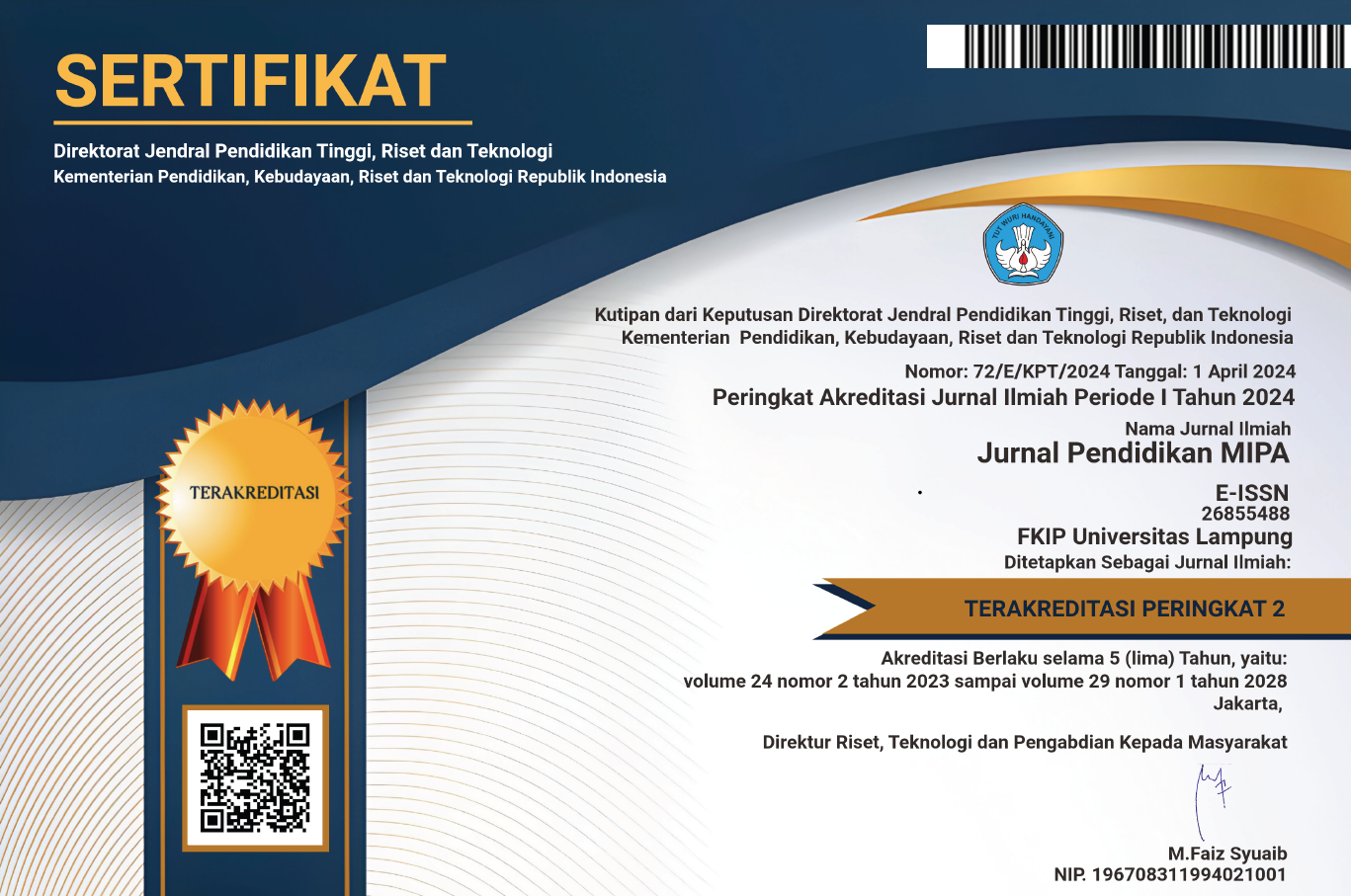Development of Android-Based Interactive Multimedia to practice Critical Thinking Skills on Mutation Materials
 Country:
Country:
(1) Walisongo State Islamic University, Indonesia
(2) Walisongo State Islamic University, Indonesia
(3) Walisongo State Islamic University, Indonesia
The purpose of this study was to determine the feasibility and response of students to interactive multimedia based on android containing critical thinking skills on mutation material. This type of research is research and development (R&D), this research was developed using the ADDIE development model (Analysis, Design, Development, Implementation, Evaluation). The sample in this study were 10 students of MAN 2 Semarang. The results of the study: 76% of media experts, 81.81% of material experts, 90% of critical thinking experts, 91.61% of teacher responses, and 92.66% of student responses to interactive multimedia applications. Based on the results of the study, it can be concluded that android-based interactive multimedia to train critical thinking skills on mutasu material is very feasible to be used as teaching material.
Keywords: critical thinking skills, interactive multimedia, development research.
Amrulloh, R., Yuliani, & Isnawati. (2013). Kelayakan teoritis media pembelajaran multimedia the feasibility theoritical of learning media of interactive multimedia in the topic of mutation for senior high school Rizqi Amrulloh [Theoretical feasibility of multimedia learning media the feasibility theoritical of learning media of interactive multimedia in the topic of mutation for senior high school Rizqi Amrulloh]. Berkala Ilmiah Pendidikan Biologi, 2, 134–136.
Branch, R. M. (2009). The ADDIE approach (1st ed.). Springer Science Business Media.
Facione, P. A. (2011). Critical thinking: What it is and why it counts. Insight Assessment.
Hastuti, T. W. (2014). Kemampuan berfikir kritis siswa SMA Muhammadiyah 2 Surakarta pada pembelajaran biologi berbasis praktikum naskah publikasi [Critical thinking ability of Muhammadiyah 2 Surakarta high school students in biology learning based on publication manuscripts] [Unpublished undergraduate thesis]. Universitas Muhammadiyah Surakarta.
Hestari, S. (2016). Validity, practicality, and effectiveness of magnetic board on gene mutation. Berkala Ilmiah Pendidikan Biologi, 5(1), 7–13.
Husein, S., Herayanti, L., & Gunawan, G. (2017). Pengaruh penggunaan multimedia interaktif terhadap penguasaan konsep dan keterampilan berpikir kritis siswa pada materi suhu dan kalor [The effect of interactive multimedia use on concept mastery and students' critical thinking skills on temperature and heat materials]. Jurnal Pendidikan Fisika dan Teknologi, 1(3), 221.
Jaknov, T. (2008). Metode penelitian pengembangan [Development research method].
Jamil, A. U., Listyono, & Norra, B. I. (2019). Pengembangan big book untuk meningkatkan high order thinking skill siswa SMP [Big book development to improve high order thinking skills of middle school students]. Bioeduca: Journal of Biology Education, 2(2), 125–134.
Khasanah, A. N., Sajidan, S., & Widoretno, S. (2017). Effectiveness of critical thinking indicator-based module in empowering student’s learning outcome in respiratory system study material. Jurnal Pendidikan IPA Indonesia, 6(1), 187–195.
Khasanah, N. (2018). Memberdayakan high order thinking skills (HOTS) melalui model discovery based unity of sciences (DBUS). Phenomenon: Jurnal Pendidikan MIPA, 8(2), 215–224.
Lu Atun Nisa, L., Setyawati, S. M., & Norra, B. I. (2019). Increasing analytical thinking skills through a popup booklet development with digestive system. Journal of Physics: Conference Series, 1241(1).
Molenda, M. (2003). In search of the elusive ADDIE model. In A. Kovalchick & K. Dawson (Eds.), Educational Technology: An Encyclopedia (Vol. 5, pp. 42).
Muliawati, D. I., & Norra, B. I. (2021). The influence of quarted card and virtual laboratory media on students’ critical thinking ability. IOP Conference Series: Earth and Environmental Science, 1796(1).
Ngurahrai, A. H., Farmaryanti, S. D., & Nurhidayati, N. (2019). Media pembelajaran materi momentum dan impuls berbasis mobile learning untuk meningkatkan kemampuan berpikir kritis siswa [Learning media for momentum and impulse based on mobile learning to improve students' critical thinking ability]. Berkala Ilmiah Pendidikan Fisika, 7(1), 62.
Norra, B. I. (2020). Pemetaan kebutuhan media pembelajaran biologi di SMP dan SMA [Mapping of biology learning media needs in middle and high schools]. Bioilmi: Jurnal Pendidikan, 6(2), 94–102.
Nuryanti, L., Zubaidah, S., & Diantoro, M. (2016). Analisis kemampuan berpikir kritis siswa kelas IX [Analysis of critical thinking ability of class IX students]. Prosiding Konferensi Nasional Penelitian Matematika dan Pembelajarannya, 2006, 179–186.
Rachmadtullah, R., Zulela, M. S., & Sumantri, M. S. (2018). Development of computer-based interactive multimedia: Study on learning in elementary education. International Journal of Engineering and Technology (UAE), 7(4), 2035–2038.
Riduwan. (2009). Dasar-dasar statistika [Basic statistics]. Alfabeta.
Saselah, D. (2017). Pengembangan multimedia interaktif berbasis Adobe Flash CS6 professional pada pembelajaran kesetimbangan kimia [Development of interactive multimedia based on Adobe Flash CS6 professional in chemical balance learning]. Jurnal Kimia dan Pembelajaran Kimia, 2(2), 80–89.
Sugiyono. (2019). Statistika untuk penelitian [Statistics for research]. Alfabeta.
Sukariasih, L., Erniwati, E., & Salim, A. (2019). Development of interactive multimedia on science learning based Adobe Flash CS6. International Journal for Educational and Vocational Studies, 1(4), 322–329.
Refbacks
- There are currently no refbacks.

This work is licensed under a Creative Commons Attribution-ShareAlike 4.0 International License.






